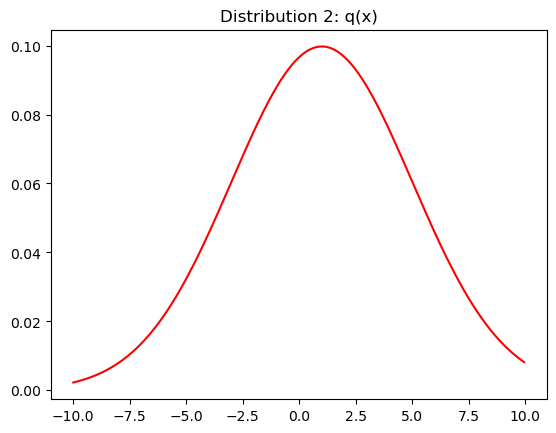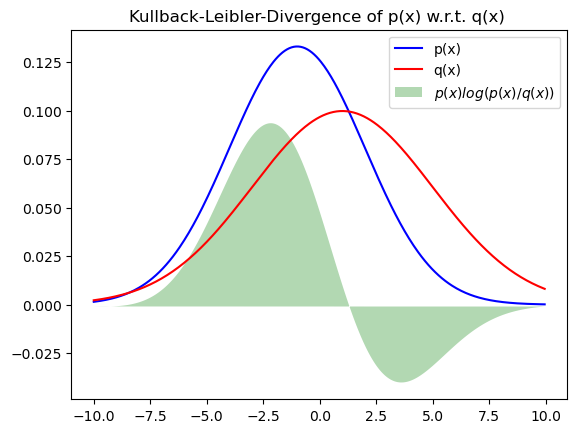Kullback-Leibler Divergence
Kullback-Leibler Divergence#
The KL-divergence is an asymmetric statistical distance measure of how much one probability distribution P differs from a reference distribution Q. For continuous random variables the KL-divergence is calculated as follows
where \(p(x)\) and \(q(x)\) are the probability density functions of the two distributions \(P\) and \(Q\).
For discrete random variables the KL-divergence is calculated as follows
In the discrete case the KL-divergence can only be calculated if \(Q(i) > 0\) for all \(i\) with \(P(i)>0\).
Below the KL-divergence of two Gaussian distributions is calculated and visualized.
import numpy as np
from matplotlib import pyplot as plt
Define the x-axis range:
dx=0.05
x=np.arange(-10,10,dx)
Define the first univariate Gaussian distribution:
mu1=-1
sigma1=3
dist1= 1/(sigma1 * np.sqrt(2 * np.pi)) * np.exp( - (x - mu1)**2 / (2 * sigma1**2))
fig,ax=plt.subplots()
ax.plot(x,dist1,"b")
ax.set_title("Distribution 1: p(x)")
plt.show()

Define the second univariate Gaussian distribution:
mu2=1
sigma2=4
dist2= 1/(sigma2 * np.sqrt(2 * np.pi)) * np.exp( - (x - mu2)**2 / (2 * sigma2**2))
fig,ax=plt.subplots()
ax.plot(x,dist2,"r")
ax.set_title("Distribution 2: q(x)")
plt.show()

Kullback-Leibler- Divergence of \(p_1(x)\) with respect to \(p_2(x)\):
klsing=dist1*np.log2(dist1/dist2)
kl=np.sum(np.abs(klsing*dx))
print("Kullback-Leibler Divergence: ",kl)
Kullback-Leibler Divergence: 0.6244355861046378
Visualization of the Kullback-Leibler Divergence. The KL-divergence is the area under the green curve:
fig,ax=plt.subplots()
ax.plot(x,dist1,"b",label="p(x)")
ax.plot(x,dist2,"r",label="q(x)")
ax.fill(x,klsing,"g",alpha=0.3,label="$p(x)log(p(x)/q(x))$")
ax.set_title("Kullback-Leibler-Divergence of p(x) w.r.t. q(x) ")
plt.legend()
plt.show()


